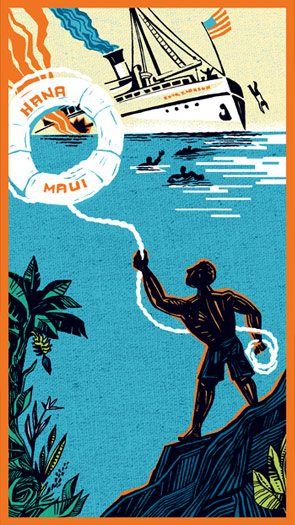Story by Peter von Buol | Illustration by Matt Foster
 Ramona Ho grew up hearing her father, Joseph Cabral, tell stories about the day he and his classmates helped rescue survivors of the Royal T. Frank, a U.S. Army transport ship sunk by a Japanese torpedo off the Hāna Coast seventy years ago this month.
Ramona Ho grew up hearing her father, Joseph Cabral, tell stories about the day he and his classmates helped rescue survivors of the Royal T. Frank, a U.S. Army transport ship sunk by a Japanese torpedo off the Hāna Coast seventy years ago this month.
Surprisingly, it seemed a story no one else remembered. . . .
On January 28, 1942, the Royal T. Frank was crossing the ‘Alenuihāhā Channel between Maui and Hawai‘i Island. Among those onboard were twenty-six soldiers from the Big Island who had just completed boot camp at Schofield Barracks on O‘ahu.
Less than two months earlier, the Japanese had bombed Pearl Harbor; since then, enemy submarines had sunk three ships in island waters, and shelled the towns of Kahului, Hilo and Nāwiliwili.
That morning, just after seven, as the Frank sailed an estimated thirty miles north of the Big Island’s ‘Upolu Point, one of the officers saw a torpedo “coming straight at us.”
His account of what happened next appeared in the February 11, 1942, New York Times, but not in the Islands, which were under martial law. The torpedo “struck opposite the starboard boiler,” the officer recalled. “There was a terrific explosion.”
That initial explosion killed everyone below deck. Above deck, shrapnel killed others, including the ship’s captain, Kahului-born Walter C. Weichert. In less than a minute, the ship sank. Of the sixty people aboard, thirty-six survived: nine soldiers and twenty-seven crew members. The survivors spent hours in the ocean, many clinging to whatever debris they could, before they were picked up by the ammunition barge that had been the actual target of the submarine.
“My father had told us the story since we were very little,” says Ramona Ho, now a librarian at Kamehameha Schools’ Maui campus. “The survivors had come ashore while Dad was at school. . . . [Most were] covered with oil and were naked.” Drilled for just such an incident, the students hurried the men to the school, helped them clean up and assembled cots for them. The Navy flew in a medic to treat them until an ambulance could traverse the winding Hāna road to bring the men out. A day later, the survivors were gone, and soon—and for decades—so was the story.
“My father said they were told by the military the incident never happened,” says Ho, “and they should ‘go home’ and not talk about it. My family didn’t talk. It was martial law and they all took it very seriously.”
Despite three-dozen survivors—and a town full of witnesses—the families of the soldiers who perished didn’t learn what had happened until after the war.
Captain Weichert’s granddaughter, Tricia Marciel, speculates that the Frank may have been on a secret mission. “Apparently my grandfather had an ominous feeling about this last voyage,” she says. “He left all of his valuables, medals, and wedding ring at home.”
Interviewed in 2010, the last living survivor of the Royal T. Frank, ninety-three-year-old Haruo Yamashita, told the Go for Broke Foundation that the vessel had been on its way to the Big Island’s Kawaihae Harbor to pick up more troops when it was hit. Yamashita and the other surviving soldiers would go on to fight in Europe, carrying with them the nickname “the Torpedo Gang.” All nine made it through the war, and each year gathered to remember those who had died aboard the Frank.
Seven decades later, a mystery remains: the wreck of the Royal T. Frank has never been found.
“It is believed to be in water too deep,” says O‘ahu-based shipwreck researcher and author Richard Rogers, “and there is not a very detailed idea of where she was torpedoed.”
As for the Japanese submarine, American depth charges sank it off the island of Bougainville in New Guinea on February 1, 1944.





